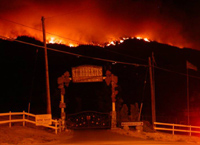B.C.
wineries never ask for rain after the middle of August, but the same fine, dry weather that has Okanagan wine growers quietly optimistic about the 2003 harvest was a key contributor to the tinder-dry landscape that is fuelling forest fires throughout wine country. The lone solution, one not yet in the forecast, is rain.
As of Tuesday, only St. Hubertus Estate Winery on Lakeshore Street in Kelowna had been damaged in the Okanagan Mountain fire, while Summerhill Pyramid Winery, CedarCreek and Pinot Reach remain evacuated as a precautionary measure. Several others remain on evacuation alert, while smoke and ash are covering vineyards from the north end of the valley to the south.
St. Hubertus owners Leo and Andy Gebert said: "The winery's administration office, wine shop and production facility were destroyed. The storage room containing bottled wine is undamaged.
"While we lost one of two family homes, we are thankful that no one was injured and we all escaped harm. As soon as we are able to do so, we are committed to rebuilding any buildings that were destroyed and returning to our love, producing great wine."
British Columbia Wine Institute marketing manager Dawn Antle reports "its members are already reaching out to the Geberts during this difficult time to provide whatever assistance they can."
The fire, which engulfed parts of the St. Hubertus property, left nearby CedarCreek Estate inexplicably untouched, demonstrating the erratic nature of wild, wind-driven forest fires.
At Vaseaux Lake, south of Okanagan Falls, the land surrounding Blue Mountain Vineyard and Winery is burned to a crisp from a fire started by an osprey's encounter with a power line, but the winery and vineyards were saved.
The Naramata bench, which runs north from the town of Penticton along the east side of Okanagan Lake, may have been saved by some timely actions taken by Mission Hill Family Estate employees at their 260-hectare Naramata Ranch.
Mike Molloy, vineyard operations manager, and winery personnel led by winemaker John Simes irrigated the 40-hectare vineyard (formerly known as Paradise Ranch) for the better part of two days before setting fire to some 200 hectares of mountain hillside along the northern perimeter of their spectacular lakeside vineyard.
The "controlled back burn" helped area firefighters connect a fire break with Chute Lake that, along with a wind change, has saved Naramata bench.
While the Naramata Ranch vineyard remains untouched, the grapes once endangered by fire now face a new threat: hungry wild animals. Mission Hill is working with local wildlife authorities to find a way to feed the wayward animals flushed from the fire zone by heat and smoke and hopefully save the grapes from an early and unconventional harvest.
Interestingly, Malloy worked the recent harvest in Australia under severe fire and smoke conditions and thinks there will be little effect on the flavour of the wine.
Tinhorn Creek winemaker Sandra Oldfield agrees. "Ash and smoke residue can be washed off in the vineyard," she said. "There could be more of a threat if the smell of smoke remains prevalent during crush, but harvest for most wineries is two to three weeks away if not more."
When I met with Oldfield last week, she was more worried about the local residents than the grapes, saying many were stressed out by the smoke that has blanketed the valley on and off for the last seven weeks, beginning with an early-season fire in Osoyoos.
Yet despite all the setbacks and the ever-present danger from a fire that has yet to be contained, most winery officials remain very optimistic about the 2003 harvest. For all its irritation, the smoke may be promoting more even ripening of the grape by partially obscuring the sun and reducing extreme mid-day temperatures that can shut down vines.
Flying ash could be a problem if it is prolonged and gets into the skin of growing grapes, thus affecting the taste of the wine, but most growers I've spoken with don't see it as a concern. If anything, the ash will eventually disappear into the soil, adding further complexity to some of the world's most complex soil types.
If there is a worry, it is an anticipated drop in tourism. August, September and October are huge months for wine tourism and wine sales could be affected if the tourists stay away.
While wineries will band together to help each other get through this crisis, what they really need is for the tourists to return. At the very least, they would like the public to know that they are open for business and awaiting your visits. All expect the highly attended Okanagan Fall Wine Festival to operate as usual.
Lower Mainlanders can help out by visiting a local liquor store or VQA wine shop and picking up an extra bottle or two of local wine and, as one official puts it, "drink the stuff."
There isn't much we can do from our armchairs to stop the fires, but buying a little extra wine is well within the realm of most consumers and it should give some extra added oomph to the Wine Institute's new slogan: It's what you bring to the table.

 quicksearch
quicksearch






